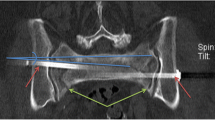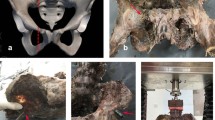Abstract
Introduction
Iliosacral screw fixation has been commonly used for stabilization of the posterior ring in unstable pelvic fractures. However, loosening of the screw may develop with or without redisplacement of the fracture. This study was undertaken to evaluate the incidence of iliosacral screw loosening and to identify its predictive factors.
Materials and methods
In total, 110 patients whose posterior pelvic ring was stabilized with iliosacral screws were enrolled. These included 9 cases of anteroposterior compression, 64 cases of lateral compression, and 37 cases of vertical shear (VS) injuries. Among those with posterior pelvic ring injuries, 95 had sacral fractures (zone I: 52, zone II: 43) and 15 had sacroiliac joint dislocations. The screws were fixed to the anterior one-third region of the first sacral (S1) body in 46 cases, and to the middle one-third region in the remaining 64 cases. If loosening of the iliosacral screw influenced the pelvic ring stability, it was considered a failure. The relationship between iliosacral screw loosening and the possible influencing factors were analyzed.
Results
Nineteen patients (17.3 %) were found to have loosening of the iliosacral screw at a mean 25.3 days postoperatively. Of these, 13 patients (11.8 %) had failure of the screws. The incidence of iliosacral screw loosening was significantly higher in those with VS injury (29.7 %, p = 0.014), in those with screw fixed to the middle one-third region of the S1 body (23.4 %, p = 0.044), and in those with VS injury combined with zone II sacral fracture (43.5 %, p = 0.019). With respect to failure of the iliosacral screw, patients with VS injury also had a higher incidence of failure (21.6 %, p = 0.036).
Conclusions
Our findings demonstrate that cases with VS injuries are prone to screw loosening, especially when combined with zone II sacral fracture. Accordingly, alternative fixation methods should be considered in such cases.







Similar content being viewed by others
References
Rommens PM, Hessmann MH (2002) Staged reconstruction of pelvic ring disruption: differences in morbidity, mortality, radiologic results, and functional outcomes between B1, B2/B3, and C-type lesions. J Orthop Trauma 16:92–98
Comstock CP, van der Meulen MC, Goodman SB (1996) Biomechanical comparison of posterior internal fixation techniques for unstable pelvic fractures. J Orthop Trauma 10:517–522
Carlson DA, Scheid DK, Maar DC, Baele JR, Kaehr DM (2000) Safe placement of S1 and S2 iliosacral screws: the ‘‘vestibule’’ concept. J Orthop Trauma 14:264–269
Griffin DR, Starr AJ, Reinert CM, Jones AL, Whitlock S (2003) Vertically unstable pelvic fractures fixed with percutaneous iliosacral screws: does posterior injury pattern predict fixation failure? J Orthop Trauma 17:399–405
Schildhauer TA, Ledoux WR, Chapman JR, Henley MB, Tencer AF, Routt ML Jr (2003) Triangular osteosynthesis and iliosacral screw fixation for unstable sacral fractures: a cadaveric and biomechanical evaluation under cyclic loads. J Orthop Trauma 17:22–31
Yinger K, Scalise J, Olson SA, Bay BK, Finkemeier CG (2003) Biomechanical comparison of posterior pelvic ring fixation. J Orthop Trauma 17:481–487
Grechenig S, Gänsslen A, Gueorguiev B, Berner A, Müller M, Nerlich M, Schmitz P (2015) PMMA-augmented SI screw: a biomechanical analysis of stiffness and pull-out force in a matched paired human cadaveric model. Injury 46(Suppl 4):S125–S128
Muller F, Fuchtmeier B (2013) Percutaneous cement-augmented screw fixation of bilateral osteoporotic sacral fracture. Der Unfallchirurg 116:950–954
Fuchs T, Rottbeck U, Hofbauer V, Raschke M, Stange R (2011) Pelvic ring fractures in the elderly. Underestimated osteoporotic fracture. Der Unfallchirurg 114:663–670
Beaulé PE, Antoniades J, Matta JM (2006) Trans-sacral fixation for failed posterior fixation of the pelvic ring. Arch Orthop Trauma Surg 126:49–52
Dolati B, Larndorfer R, Krappinger D, Rosenberger RE (2007) Stabilization of the posterior pelvic ring with a slide-insertion plate. Oper Orthop Traumatol 19:16–31
Krappinger D, Larndorfer R, Struve P, Rosenberger R, Arora R, Blauth M (2007) Minimally invasive transiliac plate osteosynthesis for type C injuries of the pelvic ring: a clinical and radiological follow-up. J Orthop Trauma 21:595–602
Acknowledgments
This work was supported by Biomedical Research Institute grant, Kyungpook National University Hospital (2015).
Author information
Authors and Affiliations
Corresponding author
Ethics declarations
Conflict of interest
None.
Additional information
The study was conducted at Kyungpook National University Hospital, Daegu, Korea.
The design and protocol of this study were approved by the institutional review board of Kyungpook National University Hospital (IRB No: KNUH 2014-08-011).
Rights and permissions
About this article
Cite this article
Kim, JW., Oh, CW., Oh, JK. et al. The incidence of and factors affecting iliosacral screw loosening in pelvic ring injury. Arch Orthop Trauma Surg 136, 921–927 (2016). https://doi.org/10.1007/s00402-016-2471-3
Received:
Published:
Issue Date:
DOI: https://doi.org/10.1007/s00402-016-2471-3




